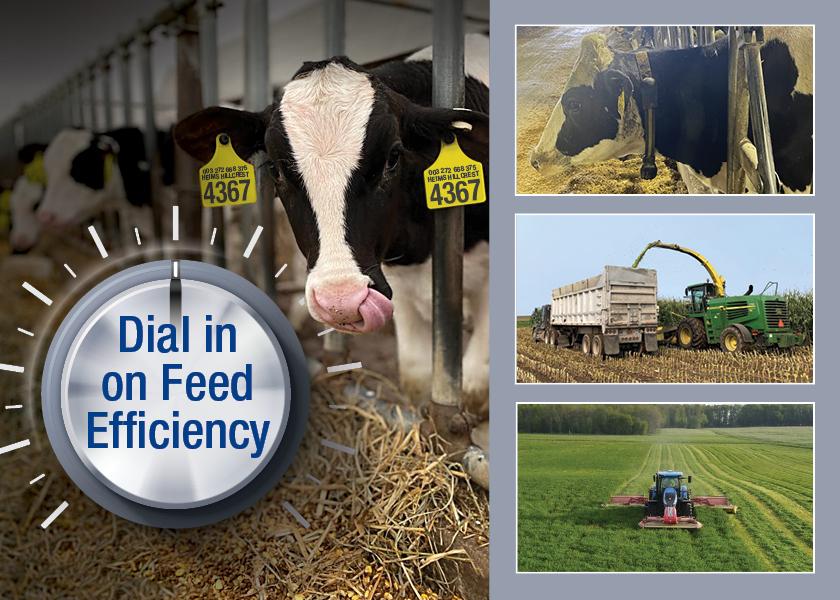Dial in on Feed Efficiency

Producers know all too well that once the feed truck comes down their driveway, a bill will follow in the mailbox. One glance at the expense side of the ledger and it is easy to see that feed is the No. 1 cost for farms. The rising cost of feed has forced dairies from coast to coast to dial in on efficiency to help boost overall profitability for the farm. Carrie Heim, the herd manager of Heim’s Hillcrest Dairy in Kewaunee, Wis., says they began using Feed One software, which has allowed them to tighten up feed efficiencies by providing a consistent ration to their herd. Heim also credits technology to helping their herd reach an 85-lb. average. The family dairy has seen a lot of upgrades and expansions since its inception in 1963, and today, the Heim’s herd consists of 800 lactating cows.
Put Technology to Work
Technology has made a noticeable impact on Heim’s Dairy, including the installation of Allflex SCR collars in 2021. The health feature alone has paid for the system, Heim says, and the software allows them to better monitor feed inventory and assists with management decisions. “It detects sick cows before they are showing signs, like 14 hours before they show signs of sickness,” she says. Cameras are another noticeable technology seen throughout Heim’s Dairy. “We can watch all day and all night long if we choose. Whenever or wherever we want,” Heim says. The farm has cameras to monitor employee safety as well as ensure good cattle welfare. “We really make sure employees are doing what they’re supposed to be doing, as well as making sure the cows aren’t running. We’re very strict on making sure the cows are treated correctly,” she adds. The farm also reduced its paper piles by implementing One Feed, a feed monitoring software, earlier this year to help streamline and standardize the feeding process.
“You can log in on a tablet or on a phone, and it’s so easy to work with,” Heim says. “It tells you your accuracy and your job time.” The feed software has also helped speed up the feeder training process. “We got the new guy up to par with feed within a couple of days versus over a week,” she says. Heim also says the feed technology software has proven successful, as it has paid for itself. “Our feeder wants to do his best. He doesn’t want to be asked, ‘what went wrong’,’” she notes. “Now he can check himself. This is important for him to recognize and acknowledge what is going on right in front of him. It has made a huge difference on our farm.”
The Finer Details of Forage
Like most operations, Heim Dairy’s nutritionist comes twice a month to implement any changes based on the needs of the herd, feed prices, etc. “Feed samples are sent to a lab every other week to ensure consistency,” Heim says. Another big ingredient when managing feed efficiency for Heim’s Dairy is the ability to grow quality homegrown feed. They chop hay every 26 days or so, depending on the weather, but monitor closely for moisture levels. “We chop as soon as we can and when the moisture is right,” she says. “Really it is all about consistency.” The farm stores its haylage and corn silage in bunker piles and pays particular attention to packing to help put up quality feed and minimize waste. “We generally have two tractors running, packing it down,” she notes. “We use an inoculant, pack as much as we can and cover immediately.” Their bunker piles are covered with one layer of plastic and topped off with whole tires. Heim’s employee who oversees the maternity barn is in charge of pushing up feed every 90 minutes.
“This falls between moving groups to and from the parlor,” Heim says. “It made sense to add this to his list of responsibilities.”
While the Heims don’t have much control over the cost of feed, they can control how they get the most out of their feed bill. Finetuning efficiencies with the help of technology and minding the details when it comes to producing homegrown forages have spelled success in more ways than one. With the help of technology, the Heim’s closely monitor production as well as reproduction. They have a low cull rate, with only 10 head leaving for slaughter monthly. Additionally, their herd components run at
> 4.25% butterfat
> 3.26% protein
> 100,000 somatic cell count







